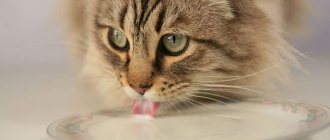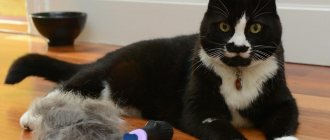Home » Useful Information
Reviews from veterinarians about anti-scratch products for cats are very contradictory.
Some consider soft claws a humane and safe way to solve the problem of scratches on furniture and on the body, others consider them an outrage against the natural instincts of the animal, and others consider them simply a glamorous decoration.
Let's try to figure out this seemingly simple question together.
Feedback from veterinarians regarding anti-scratch products for cats upsets many lovers of these affectionate animals.
On the one hand, thanks to silicone pads, the cat’s habit of sharpening its claws ceases to poison the joy of communicating with a four-legged family member.
On the other hand, all this talk about inhumane treatment of pets raises certain doubts and adds a fly in the ointment.
What people don’t come up with so that the cat’s instincts are realized and the domestic idyll is not disturbed.
Some make scratching posts with their own hands , others buy ready-made options built into the cat house , and still others buy multi-colored anti-scratch pads.
If you want to make a cat house with your own hands, we recommend reading the article
This is what silicone pads for cat claws look like
- 2 At what age can cats be given anti-scratch pads?
- 3 How often should you change claw covers?
- 4 Veterinarian's opinion
- 5 Veterinarian consultation
- 6 Vet tips
Ways to get rid of cat claws
Pet stores offer special pheromones and anti-scratch sprays. This remedy is not always effective, since the cat continues to sharpen its claws on sofas and armchairs, in addition to the carefully prepared scratching post.
A more effective, but downright cruel way to save property is onychectomy. This is an operation to remove a cat's claw with part of a finger, leading to disruption of the musculoskeletal system, pain, coordination problems, arthritis and other diseases. After it, the animal’s uniform load on the body’s muscles is disrupted, some of them experience overload, and others begin to atrophy.
The cat becomes disabled, increasingly uses its teeth and ceases to maintain hygiene in the tray due to the inability of its sore paws to turn over the litter. Often such animals end up on the street and die there.
As an alternative to surgical intervention, anti-scratchers for cats have been invented - soft claws, which are designed to stop the cutting off of cat's toes. This is a real salvation for an animal's health - an individual cover for each claw, made of multi-colored plastic, rubber or silicone.
Is there any harm to cats?
The pads do not cause any harm to humans; on the contrary, they relieve scratches and inflammatory processes.
A cat's natural claws will not be damaged if you choose the right size of anti-scratch claws. At the same time, the coatings are preserved without damage.
But not all cats are the same in character. Some people will not like this version of the problem, and until they get rid of plastic masks, they will not calm down. Gnawing on the pads can damage the teeth and there is a risk of swallowing the tip. But it is made from animal material that is safe for the body and has a smooth shape, so when it enters the body, the tip will calmly pass through the esophagus and come out without causing harm.
Why are anti-scratch pads needed?
The functional purpose of this invention is quite broad; claws have a huge number of advantages:
- Protects furniture from being torn apart.
- They keep the animal healthy and look aesthetically pleasing.
- Protect cat owners in case of health problems. With anti-scratch protection, the cat will no longer be able to cause a wound and cause infection.
- They will protect children and adults from a playful kitten.
- They will save your pet from showing jealousy towards another family member or animal.
- Will stop attempts to scratch or tear off stitches after surgery.
- They will provide accommodation in a clean and tidy apartment, as the cat can use the litter box without any problems.
- Bathing a pet becomes a less dangerous activity for the owner.
Main advantages
The obvious benefits of using anti-scratch products are primarily experienced by the cats themselves: for about two months there are no scandals in the house from accidentally torn wallpaper or scratched furniture. In addition, pets:
- They generally do not experience any inconvenience associated with impaired claw mobility. They are great at releasing them and hiding them when necessary. Nails continue natural growth;
- retain their habits. Often, after radical trimming or complete removal of claws, there may be a lack of coordination, motor activity decreases, and gait changes. The use of anti-scratch pads guarantees quick adaptation of cats;
- do not experience stress and are protected from accidental injuries that are inevitable when trimming claws.
Silicone rescue for furnishings and floors serves as an excellent reason for reconciling strict adherents of order and their active pets:
- you don’t have to worry about the safety of your interior items and at the same time enjoy your cat’s mobility;
- The bathing process, which will certainly be stressful for all participants, will become less dangerous, as will attempts to give the cat medicine - the claws will not be involved in this process.
An absolute advantage is the absolute confidence that with anti-scratch protection the cat will not be able to injure the child, even by accident. Although even for adults, scratches will no longer be scary.
When not to use anti-scratch products
Veterinarians have mixed opinions about wearing nail guards. Firstly, putting caps on is stressful for your pet. Secondly, the opportunity to satisfy the natural need to grind off the claws is lost. Anti-scratch products are not recommended when:
- the cat walks on the street, because in case of danger, it will not be able to climb onto a hill or protect itself;
- the kitten is less than 6 months old;
- the cat, due to old age, no longer scratches either people or furniture;
- The animal has an allergic reaction to the glue.
Mounting features: consequences of incorrect installation
False nails for cats are protection for the home interior and peace of mind for the owners. Do not use them on animals whose claws are still developing or have diseases. Such attachments can prevent a growing organism from fully developing and learning about the world. Older cats of advanced age do not need such accessories at all. Such pets have long lost interest in games and damaging furniture.
Many owners wonder: Is my furry friend in pain? What if he swallows them? There is no reason to worry. The cat claw attachments are made from non-toxic silicone with a soft, streamlined design for a reason. If a kitten accidentally swallows one of these, it will easily pass through the gastrointestinal tract.
At first, it may seem that using stickers on your cat’s claws is an expensive proposition. But this is only the first time. The longer your pet wears the attachments, the less he removes or chews them, which means he wears them longer. On average, replacement occurs once a month: cat nails simply fall off along with the stratum corneum naturally
If there are children living in the house, pay attention to colored stickers. Since kids love to try everything new and unusual to taste, the use of colorful accessories will help parents quickly find and remove those that have fallen off.
Note! When choosing claw pads for your pet, consider its size. Be sure to weigh your pet before going to the store.
Incorrectly attached silicone nail pads can cause ingrown nails, so make sure that they do not fit too tightly to the base. If you do not take this nuance into account, it will be painful for the animal to walk and play, it will not be able to painlessly extend and hide its claws, it will not be able to play or walk normally.
Myths about claw pads
Manufacturers claim that silicone tips are completely safe for the animal, even if it swallows them. In rare cases, an allergy to the glue may occur, but it is not toxic. In Russia, there are myths about anti-scratch kits among cat owners:
- The claws itch under the caps. The assumption itself is absurd, since the claws do not have nerve endings, otherwise it would be impossible to trim or sharpen them painlessly.
- Nail guards prevent the claws from retracting. This is not true, given that the anti-scratch pads are glued to the tip sticking out of the pillow. If the cap is placed very deeply on the claw, the cat may experience discomfort, but if everything is done correctly, the pet’s movements will not be constrained.
- The gait changes. To some extent, this statement is a fact, since at first the animal gets used to the innovation and experiences stiffness in its movements. After an adaptation period, the cat begins to move confidently and calmly again.
- The glue and material used to make the attachments are toxic. Manufacturers completely refute this statement; a cat can easily chew and swallow the cap, it will come out naturally without harm to health.
FAQ
Some cat owners are in no hurry to put anti-scratch pads on their pets for fear of harming the cat's health. In some cases, fears are unfounded.
Do pads affect nail growth?
No, that's not happening. The habitual change of claw occurs in a cat within 1.5-2 months, then the silicone device itself comes off with the upper stratum corneum of the old claw. In active, playful cats, the anti-scratch pads may come off earlier due to the fact that movement creates vibration, which reduces the fixing properties of the glue.
From what age can it be used?
There are no strict age restrictions, but veterinarians recommend gluing anti-scratch pads at 6 months or later. Small kittens have soft claws that hardly damage the interior and are renewed much faster due to the growth of their paws.
Therefore, it makes no sense to glue protection to cat babies up to six months.
Is it safe for your pet?
When using special glue there is no danger to the cat's health. The procedure is painless, and the discomfort after fixing the anti-scratch goes away within a few days.
Gluing is only allowed on healthy cats with intact claws. Wounded paws or cracks in the claw are a contraindication for silicone pads. You need to wait until the pet recovers and then glue the caps.
Disadvantages of anti-scratch pads
In addition to myths, you can hear unpleasant reviews about silicone caps:
- The pet's movement around the apartment becomes noisy. To solve this problem, nail guards can be glued only to the front paws.
- Slow getting used to the “manicure”. The adaptation period is individual for each animal, but if the anti-scratch pads are applied correctly, the cat should not experience discomfort for a long time.
- Rapid wear of the caps. On average, the attachments last for a month, but some cats manage to remove them much earlier. In this case, it is recommended to have spare ones.
- Nails prevent the cat from performing hygiene procedures: cleaning its ears and teeth. This concern falls entirely on the shoulders of the owner.
Floor scratching posts
There are different floor scratching posts - flat, columns, combined with a bed or a house. They take up a lot of space in the house, but in some cases they are irreplaceable. Flat and heavy floor mounts will help out when the wall material does not allow wall mounts to be attached to them. And you don’t want to constantly trip over light cat rags made of cardboard or fabric that the cat drags around the entire apartment. A floor-mounted claw clipper located under the table will not disturb anyone. The poles will be very good for an active and young cat if there is no place for him to climb in the apartment and there is no way to go outside. Complex complexes with houses and beds will be especially useful where there are several cats and kittens are often born. All animals will have a place to frolic, and they will not constantly get underfoot, scratch and damage furniture.
Flat floor scratching posts
Making a flat, floor-mounted cat scratching post is very easy. To do this, you need to take as a base a piece of wooden board, chipboard or multi-layer plywood 40-50 cm wide and 70-100 cm long. A part from an old cabinet is perfect for this. The base can be wrapped on both sides with carpet with a fabric base, the wrong side out. An old wool rug is ideal for this.
How to use the pads
The most correct decision when putting on anti-scratch pads for the first time would be to consult a veterinarian. He will tell you about all the nuances and show how to put the caps on correctly without compromising the health of the pet and the owner.
The sizes of the nozzles are selected based on the size of the cat:
- up to 6 months, pads are contraindicated;
- XS – for kittens and cats weighing from 0.5 to 2.5 kg;
- S – animal from 2 to 4 kg;
- M – cat from 4 to 6 kg;
- L – pet from 6 kg or more.
Trying on anti-scratches is carried out immediately before gluing them. If the owner made a mistake with the size, you can trim the caps a little or buy others that are suitable in size.
The nozzle should fit tightly around the claw, not slip off, and the distance to the base of the claw is at least 3-5 mm.
Reviews from owners and veterinarians
Sometimes cat owners devote so much time and effort to caring for their pet that it becomes difficult not to share their experience with others
There are many online forums devoted to topics about cats and cats. Cat breeders share their victories and disappointments, experiences and knowledge. And sometimes inexperienced pet owners just need advice. Few owners know about anti-scratches. Those who have already tried to use them are either satisfied with the device (and praise it) or disappointed (and criticize it). Some people who tried anti-scratch products got completely unexpected results.
I glued these to my cat, they are great. What’s funny is that I haven’t even run out of one box, but I stopped gluing them to him, I just continue to cut them, because he’s used to his nails not being scratched and has stopped even tearing up rugs. But I glued them to him from a young age. When you glue, make sure that the glue with the cap does not stick to the finger, otherwise the nail will grow and it will hurt the cat.
Forum user
https://m.woman.ru/home/animal/thread/4363561/https://m.woman.ru/home/animal/thread/4363561/
It often happens that after improper use unpleasant consequences occur. And the point here is not in the shape of the caps, or even in the quality of the glue. It’s just that every new item always evokes many different emotions. And here it’s up to you to decide whether to use it or not.
These anti-scratches are not needed, I was convinced from my own experience. I bought them for my cat, now I am suffering both myself and the cat. She took off all these caps, I didn’t re-sculpt them so as not to torture the animal, but one of her caps couldn’t be removed, and the nail festered. Today I wanted to take her to the vet, but Sunday is a day off, and in the evening I’m going on a business trip until Friday, how will my cat be here without me.
tory11, forum visitor
https://www.zoovet.ru/forum/?items=20&page=2&tem=307273&tid=18
Operating procedure
First of all, you need to take the cat on your lap, pet it, and let it relax. If she breaks free and runs away, in preparation for the gluing process, you need to give her the opportunity to calm down and unobtrusively massage her paws.
Steps to put on anti-scratch boots:
- without touching the parts where the blood vessel and nerve pass, you need to trim the part of the claw that bends downwards with a hook by 1 mm;
- disinfect with any antiseptic;
- Fill the cap one third with glue, so that the excess does not stick the wool together when it subsequently flows out;
- press on the pet’s paw pad so that it releases its claws, put on the pad with glue, stepping back 2 mm from the skin, hold for a few seconds for better fixation;
- hold the cat in your arms until the glue dries completely.
If the cat cannot get used to the pads or they are glued incorrectly, the caps must be removed. If the animal behaves calmly, sooner or later they will disappear on their own.
general information
Let's start with public opinion, or more precisely, with three categories of opinions. As you understand, the owners choose one that is acceptable to them and stick to it. So, the first group considers anti-scratch caps to be a harmful accessory on which Chinese manufacturers make money, the second group is of the opinion that anti-scratch caps are an integral part of maintaining order in the house, and the third group considers caps to be decorations and nothing more.
I don’t want to argue with the first group, but it’s worth stating one fact. Anti-scratch devices were invented not by the Chinese, but by the Americans, that is, the patent for the accessory belongs to the United States. The idea came from veterinarians who were looking for an alternative to declawing. By the way, this, to put it mildly, inhumane procedure was also “invented” in the USA. Many countries have banned animal declawing at the legislative level; the American government has not introduced such bans, but owners have been offered an alternative. The conclusion is that “profiteering” is taking place, since declawing and claw padding are two expensive procedures that cat owners resort to.
The next point is the ambiguous presentation of your product on the market. Consumers are confident that the caps are designed to protect furniture and wallpaper from scratching. Anti-scratch products should not be used for a long time, and scratching is one of the forms of normal behavior of cats. Even the instructions for this accessory contain a warning that the caps need to be changed and the cat’s claws need to be looked after (since the cat is deprived of such an opportunity).
In fact, anti-scratch pads were invented as a temporary solution to the following problems:
Avoiding pet fights during the adaptation period - if you decide to get a kitten or puppy, an adult may become jealous of cats
If the owner works and cannot control the behavior of the pets, the older cat is given anti-scratch guards for 1–2 weeks.
Adaptation period to a child – cats are known for their intolerant attitude towards those who distract the owner’s attention. Very often the subject of a pet’s dissatisfaction is a baby that appears in the house.
During the adaptation period of 1-2 weeks, while the cat gets used to the new family member, she is given rubber caps to ensure that the baby is protected from scratches.
Repair is a very stressful situation for a cat, which can lead the pet to attack not only strangers (workers, guests), but also the owners. With the right approach, the pet will adapt to the new environment in a few weeks, and during this time, anti-scratch treatments are used to avoid serious attacks.
Education - many people decide to adopt an adult cat, whose character may need adjustment. For the period while the pet gets used to the new environment, the tray, scratching post, all family members use anti-scratch pads as guaranteed protection against attacks.
Dermatitis and other skin diseases that cause itching - if the face is affected, you can use a collar, but if the disease affects the body, the cat will quickly scratch the skin to the point of wounds. To protect your pet from secondary skin infection and speed up the healing process, use silicone claw pads.
The conclusions are obvious - wearing caps is a forced and temporary measure. In such situations, you can and should use rubber caps.
We’ll talk about how to choose and put on claw pads a little later.
It's time to pay attention to the myths and facts about using anti-scratch products
Mr. Cat recommends: the opinion of veterinarians
Veterinarians believe that the procedure of putting on anti-scratch guards can cause stress for up to several weeks even in a calm animal. With attachments, the cat cannot fully wash itself, does not feel the surface on which it moves, all this causes discomfort. Doctors advise:
- Attach the caps only to healthy paws. If there are injuries, irritation, fungal or infectious lesions, the animal must first be treated.
- When the anti-scratch pads are already glued, you need to regularly inspect the paws for fungus or infection.
- Apply the pads carefully to prevent glue from getting on the skin, since as the claw grows, painful cracks may form on the skin, which are favorable for the development of infection.
- If an allergy to glue manifests itself in the form of irritation or swelling, you must immediately contact a veterinarian and remove the anti-scratch protectors.
Pet's reaction
If your pet is not accustomed to regular nail treatment, it may resist and behave aggressively. To overcome resistance, it is highly recommended to show affection and give your cat a massage.
During the first few days, the animal will try to chew on cat scratches; this is quite normal. Fallen pads must be replaced with new ones. If the animal remains restless after several days and constantly reaches for its paws, then it is quite possible that the pads cause pain or discomfort. You need to carefully examine the front legs.
Expert advice
The procedure for gluing claw covers is best done with someone in pairs . One holds the cat, the second glues anti-scratch pads.
If your pet likes to kick, wrap it in a thick blanket. At the end of the cosmetic session, keep an eye on the cat: if she tears off (gnaws off) a couple of pads, glue on new ones. But if there is a persistent rejection of manicure and nervousness that lasts more than 3 days, leave the animal alone.
An alternative to “soft claws” is a regular scratching post. In the end, give the cat an old leather suitcase, an ironing board, or... resign yourself to a tattered sofa and walls.
Return to content










